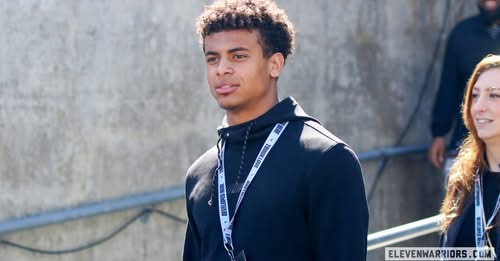Ohio State’s 2026 recruiting class took a hit as four-star cornerback Jakob Weatherspoon decommitted and announced his commitment to North Carolina.
Ohio State’s 2026 recruiting class has experienced a shakeup, and it’s a significant development in the ever-changing world of college football recruiting. The Buckeyes, who have built a reputation for stacking top-tier talent year after year, saw their class shrink by one as four-star cornerback Jakob Weatherspoon flipped his commitment from Ohio State to North Carolina. This decision comes as a surprise to many, considering the consistent dominance Ohio State has shown both on the recruiting trail and on the field. Yet, in today’s era of name, image, and likeness deals, transfer portal opportunities, and increased competition for elite prospects, nothing is guaranteed until signing day. For the Buckeyes, this is a reminder that recruiting battles are never truly over, and for North Carolina, it marks a huge win as they continue to strengthen their roster for the future.
Weatherspoon’s decision to flip to North Carolina speaks volumes about the competitive nature of modern recruiting. The 6-foot-1, 185-pound defensive back from Georgia had been considered a solid Ohio State commitment for months. His size, athleticism, and ability to lock down opposing receivers made him an ideal fit for a program like Ohio State, which prides itself on producing elite NFL-caliber defensive backs. From the moment he committed, Ohio State fans envisioned him as part of a future secondary that could rival any in the country. But recruiting is fluid, and programs like North Carolina never stop pushing, even when a player is verbally committed elsewhere.
So what happened? Why did Weatherspoon make the switch? According to sources close to the situation, relationships played a key role. North Carolina’s coaching staff, particularly defensive backs coach Jason Jones and head coach Mack Brown, made Weatherspoon a top priority and maintained consistent communication even after his Ohio State pledge. They sold him on being an immediate impact player in their system and emphasized how their defense is evolving into a scheme that can showcase his skills. On top of that, NIL opportunities in the modern game cannot be ignored. While nothing has been confirmed publicly, it’s widely understood that programs in the ACC, like UNC, have stepped up their efforts to compete with the SEC and Big Ten when it comes to NIL packages for recruits.
Ohio State, on the other hand, still has one of the most impressive defensive back recruiting traditions in the nation. From names like Jeff Okudah to Denzel Ward and Marshon Lattimore, the Buckeyes have earned the moniker “DBU” from many analysts. That legacy was no doubt part of the initial appeal for Weatherspoon, but sometimes the combination of early playing time, relationships, and the chance to be a cornerstone for a program like UNC becomes too tempting to pass up. North Carolina might not have the same national championship pedigree as Ohio State, but they do offer a unique opportunity for players who want to help elevate a program to new heights.
For Ohio State fans, this news is disappointing but not devastating. Ryan Day and his staff have built one of the strongest recruiting operations in the country, and one decommitment—even from a highly regarded four-star corner—is unlikely to derail their overall class. As of now, Ohio State still boasts a top-tier 2026 recruiting class loaded with talent on both sides of the ball. However, this move could serve as a wake-up call that in today’s recruiting landscape, programs cannot take any commitment for granted. With NIL money flowing and the transfer portal providing athletes more flexibility than ever, commitments are becoming more like stepping stones than final decisions.
The ripple effect of Weatherspoon’s flip could also influence other recruits. Recruiting is often about perception, and when a player of Weatherspoon’s caliber switches programs, it can spark conversations among other prospects considering both schools. For North Carolina, landing a player who was once committed to a perennial powerhouse like Ohio State sends a strong message to future recruits that the Tar Heels are serious about competing on a national level. For Ohio State, the staff will likely double down on efforts to lock in their current commitments and perhaps pursue other defensive back targets who can fill the void left by Weatherspoon’s departure.
In terms of on-field implications, Ohio State is not in panic mode. The Buckeyes routinely sign multiple elite defensive backs in each class, and they have shown a remarkable ability to develop talent regardless of recruiting rankings. Players like three-star recruit Malik Hooker, who became a first-round NFL draft pick, are proof that Ohio State can turn under-the-radar prospects into stars. That being said, losing a four-star player who fits the mold of a prototypical modern cornerback—tall, fast, and physical—always stings. It’s the kind of loss that could matter down the line if depth becomes an issue or if another top target slips away.
As for North Carolina, this commitment is another step forward in Mack Brown’s efforts to elevate the Tar Heels into an ACC powerhouse. Brown has made it clear since his return to Chapel Hill that the goal is to recruit and develop players who can help UNC compete for conference titles and College Football Playoff spots. Landing a player like Weatherspoon fits that blueprint perfectly. He gives the Tar Heels a potential shutdown corner for the future, which is critical in an era where passing offenses dominate college football. For a team looking to challenge Clemson, Florida State, and Miami for ACC supremacy, adding elite defensive talent is essential.
This move also illustrates the shifting dynamics of college football geography. For decades, the assumption was that southern recruits, especially from talent-rich states like Georgia, would either stay in the SEC footprint or head to national brands like Ohio State. But the combination of NIL deals, aggressive recruiting strategies, and new program ambitions has leveled the playing field somewhat. Schools like North Carolina are now legitimate contenders for blue-chip prospects who might not have given them a second look a decade ago. That’s good for parity in college football, even if it frustrates fan bases accustomed to scooping up every top recruit without much resistance.
From a broader perspective, Weatherspoon’s flip underscores why recruiting is the lifeblood of college football and why it’s as unpredictable as it is fascinating. Coaches are constantly battling not just rival programs but also shifting rules, new financial realities, and the personal priorities of teenage athletes making life-changing decisions. What seems like a lock one day can unravel the next, and the domino effect can alter the trajectory of entire programs. For every Ohio State fan disappointed today, there’s a North Carolina fan celebrating—and that contrast is what makes recruiting such a compelling subplot to the actual games on the field.
Looking ahead, Ohio State will regroup quickly. They always do. The Buckeyes have the resources, the track record, and the national brand to continue attracting elite talent, and they remain a top destination for defensive backs aiming for NFL careers. Expect Ryan Day’s staff to identify new targets and perhaps even swing for an even bigger name to make up for this loss. Meanwhile, North Carolina will savor this victory and use it as a recruiting tool to attract even more talent. They can now point to Weatherspoon as an example of a player who chose the Tar Heels over one of the biggest names in college football—a narrative that resonates with other high school stars looking to make a name for themselves.
In the end, this is just one chapter in the never-ending story of college football recruiting, a story filled with twists, turns, and surprises that keep fans and analysts on edge. For Ohio State, the message is clear: stay relentless, stay adaptable, and never assume a commitment is final. For North Carolina, it’s proof that persistence pays off and that the gap between traditional powerhouses and ambitious programs is narrowing. Jakob Weatherspoon’s decision may seem like a single flip in the grand scheme of things, but it represents so much more about where the sport is headed—a future where every program has a fighting chance, and every commitment is worth fighting for until the ink is dry



